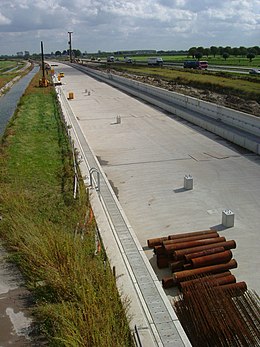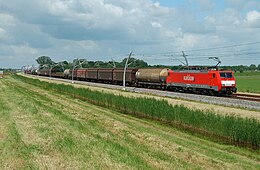
The Netherlands is both a very densely populated and a highly developed country in which transport is a key factor of the economy. Correspondingly it has a very dense and modern infrastructure, facilitating transport with road, rail, air and water networks. In its Global Competitiveness Report for 2014-2015, the World Economic Forum ranked the Dutch transport infrastructure fourth in the world.
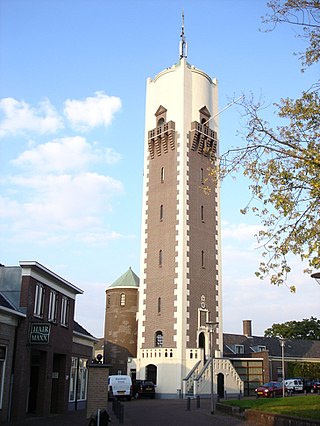
Barendrecht is a town and municipality in the west of the Netherlands, near Rotterdam, South Holland. The municipality had a population of 48,643 in 2021, and covers an area of 21.73 km2 (8.39 sq mi) of which 1.98 km2 (0.76 sq mi) is water.
This list of train routes in the Netherlands focuses on the routes taken by trains travelling on railway lines in the Netherlands. A list including all stops on the train routes can be found at Dutch railway services.

The Iron Rhine or Steel Rhine is a partially nonoperational freight railway connecting the port of Antwerp (Belgium) and Mönchengladbach (Germany) by way of Neerpelt and the Dutch towns of Weert and Roermond.

The Maasvlakte is a massive man-made westward extension of the Europoort port and industrial facility within the Port of Rotterdam. Situated in the municipality of Rotterdam in the Netherlands, the Maasvlakte is built on land reclaimed from the North Sea.

The HSL-Zuid, is a 125 kilometre-long Dutch high-speed railway line running between the Amsterdam metropolitan area and the Belgian border, with a branch to Breda, North Brabant. Together with the Belgian HSL 4 it forms the Schiphol–Antwerp high-speed railway. Originally scheduled to be in service by 2007, the first public operations began on 7 September 2009, after a ceremony on 6 September.
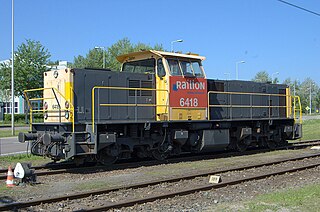
The NS Class 6400 is a type of 4 axle diesel-electric freight locomotive. 120 were built by MaK and ABB between 1988 and 1994 for Nederlandse Spoorwegen.
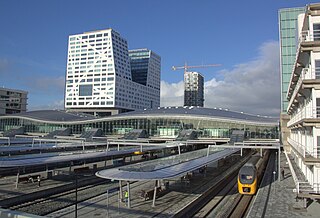
Utrecht Centraal, officially Station Utrecht Centraal, is the transit hub that integrates three bicycle parkings, two bus stations, two tram stops and the central railway station for Utrecht, Netherlands. It is the biggest train station in the Netherlands.

Belgium's high-speed rail network provides mostly international connections from Brussels to France, Germany and The Netherlands. The high-speed network began with the opening of the HSL 1 to France in 1997, and since then high-speed lines have been extended towards Germany with HSL 2 in 2002, HSL 3 from Liège to the German border in 2009, and HSL 4 from Antwerp to the Dutch border in 2009.

Rail transport in the Netherlands uses a dense railway network which connects nearly all major towns and cities. There are as many train stations as there are municipalities in the Netherlands. The network totals 3,223 route km (2,003 mi) on 6,830 kilometres (4,240 mi) of track; a line may run both ways, or two lines may run on major routes. Three-quarters of the lines have been electrified.

The history of rail transport in the Netherlands is generally considered to have begun on September 20, 1839, when the first train, drawn by De Arend, successfully made the 16 km (9.9 mi) trip from Amsterdam to Haarlem. However, the first plan for a railroad in the Netherlands was launched only shortly after the first railroad opened in Britain.

Barendrecht railway station is a railway station in Barendrecht, Netherlands, located on the Breda–Rotterdam railway between Rotterdam and Dordrecht. Adjacent to the four tracks of this line are two tracks for the HSL-Zuid and three for freight, as part of the Betuweroute freight route to Zevenaar. The nine tracks are in a 1.5 kilometers (0.93 mi) long roofed structure, much of it covered under a layer of earth, to keep noise at bay. On top is a new city park. At the station itself its four tracks, with the platforms, have a glass roof.
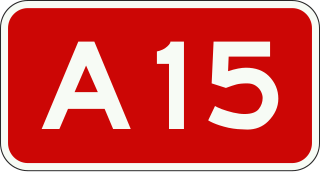
The Dutch A15 motorway is a set of two motorways in the Netherlands, the A15 and the A18.
Trailer on flatcar, also known as TOFC or piggyback, is the practice of carrying semi-trailers on railroad flatcars. TOFC allows for shippers to move truckloads long distances more cheaply than can be done by having each trailer towed by a truck, since one train can carry more than 100 trailers at once. The trailers will be moved by truck from their origin to an intermodal facility, where they will then be loaded onto a train, typically by a rubber tyred gantry crane, for the bulk of their journey. Alternatively, trailers may be driven onto the flatcars via ramps by a terminal tractor. Near the destination, the trailers are unloaded at another facility and brought to their final destination by a tractor unit.

Kijfhoek classification yard is a hump yard type freight rail yard between Rotterdam and Dordrecht in the western Netherlands. The rail yard is named after the nearby village Kijfhoek in the municipality Zwijndrecht. With an area of 50 hectares Kijfhoek is the largest of the few railway yards left in the country. The rail yard has a key function in connecting the rail network at the Port of Rotterdam with the rest of the Netherlands, Belgium and Germany.

The Oberhausen–Arnhem railway is a two-track, electrified main line railway running close to the lower Rhine from Oberhausen via Wesel, Emmerich and the German–Dutch border to Arnhem and forms part of the line between the Ruhr and Amsterdam. The line was opened by the Cologne-Minden Railway Company in 1856 and is one of the oldest lines in Germany.

The Amsterdam–Arnhem railway, also referred to as the Amsterdam–Elten railway or Rhijnspoorweg in Dutch, is an important railway that connects Amsterdam in the Netherlands with Utrecht and Arnhem, and continues into Germany.

The Geldersch-Overijsselsche Lokaalspoorweg-Maatschappij (GOLS) was a railway company that owned and serviced several railways in the Dutch provinces of Gelderland and Overijssel. The company was founded by Jan Willink, a textile producer from Winterswijk, who had created the Borken - Winterswijk - Zutphen railway in 1878.


